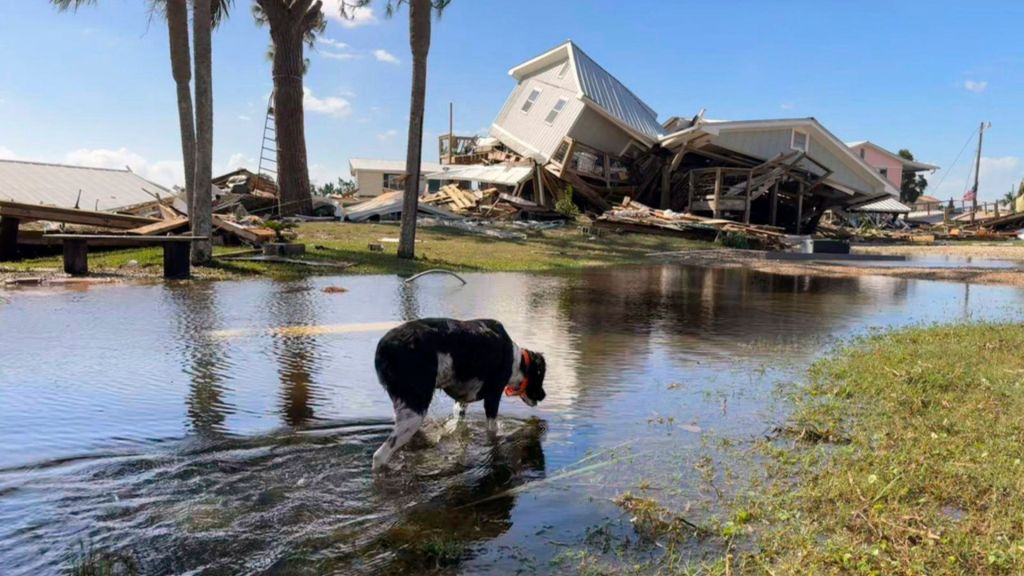By Stephen Smith, Kate Payne and Heather Hollingsworth
The Associated Press
PERRY, Fla. (AP) — Hurricane Helene left an enormous path of destruction across Florida and the southeastern U.S. on Sept. 27, killing at least 44 people, snapping towering oaks like twigs and tearing apart homes as rescue crews launched desperate missions to save people from floodwaters.

Among those killed were three firefighters, a woman and her 1-month-old twins, and an 89-year-old woman whose house was struck by a falling tree. According to an Associated Press tally, the deaths occurred in Florida, Georgia, North Carolina, South Carolina and Virginia.
The Category 4 hurricane knocked out power to some hospitals in southern Georgia, and Gov. Brian Kemp said authorities had to use chainsaws to clear debris and open up roads. The storm had maximum sustained winds of 140 mph (225 kph) when it made landfall late Sept. 26 in a sparsely populated region in Florida’s rural Big Bend area, home to fishing villages and vacation hideaways where the state’s panhandle and peninsula meet.
Moody’s Analytics said it expects $15 billion to $26 billion in property damage.
The wreckage extended hundreds of miles northward to northeast Tennessee, where a “dangerous rescue situation” by helicopter unfolded after 54 people were moved to the roof of the Unicoi County Hospital as water rapidly flooded the facility. Everyone was rescued and no one was left at the hospital as of late Sept. 27, Ballad Health said.
In North Carolina, a lake featured in the movie “Dirty Dancing” overtopped a dam and surrounding neighborhoods were evacuated, although there were no immediate concerns it would fail. People also were evacuated from Newport, Tennessee, a city of about 7,000 people, amid concerns about a dam near there, although officials later said the structure had not failed.
Tornadoes hit some areas, including one in Nash County, North Carolina, that critically injured four people.
Atlanta received a record 11.12 inches (28.24 centimeters) of rain in 48 hours, the most the city has seen in a two-day period since record keeping began in 1878, Georgia’s Office of the State Climatologist said on the social platform X. The previous mark of 9.59 inches (24.36 cm) was set in 1886. Some neighborhoods were so badly flooded that only car roofs could be seen poking above the water.
Climate change has exacerbated conditions that allow such storms to thrive, rapidly intensifying in warming waters and turning into powerful cyclones sometimes in a matter of hours.
When Laurie Lilliott pulled onto her street in Dekle Beach, Florida, after Helene plowed through, she couldn’t see the roofline of her home beyond the palm trees. It had collapsed, torn apart by the pounding storm surge, one corner still precariously propped up by a piling.
“It took me a long time to breathe,” Lilliott said.
As she surveyed the damage, her name and phone number were still inked on her arm in permanent marker, an admonition by Taylor County officials to help identify recovered bodies in the storm’s aftermath. The community has taken direct hits from three hurricanes since August 2023.
All five who died in one Florida county were in neighborhoods where residents were told to evacuate, said Bob Gualtieri, the sheriff in Pinellas County in the St. Petersburg area. Some who stayed ended up having to hide in their attics to escape the rising water. He said the death toll could rise as crews go door-to-door in flooded areas.
More deaths were reported in Georgia and the Carolinas, including two South Carolina firefighters and a Georgia firefighter who died when trees struck their trucks.
Video on social media showed sheets of rain and siding coming off buildings in Perry, Florida, near where the storm hit land. A news station showed a home that was overturned, and many communities established curfews.
Also in Perry, the hurricane peeled off the new roof of a church that was replaced after Hurricane Idalia last year.
When the water hit knee-level in Kera O’Neil’s home in Hudson, Florida, she knew it was time to escape.
“There’s a moment where you are thinking, ‘If this water rises above the level of the stove, we are not going to have not much room to breathe,’” she said, recalling how she and her sister waded through chest-deep water with one cat in a plastic carrier and another in a cardboard box.
President Joe Biden said he was praying for survivors, and the head of the Federal Emergency Management Agency headed to the area. The agency deployed more than 1,500 workers, and they helped with 400 rescues by late morning.
In Tampa, some areas could be reached only by boat.
Officials urged people who were trapped to call for rescuers and not tread floodwaters, warning they can be dangerous due to live wires, sewage, sharp objects and other debris.
More than 3 million homes and businesses were without power in Florida, Georgia and the Carolinas as of late Sept. 27, according to poweroutage.us. The site also showed outages as far north as Ohio and Indiana due to Helene’s rapid northward movement throughout the day.
In Georgia, an electrical utility group warned of “catastrophic” damage to utility infrastructure, with more than 100 high voltage transmission lines damaged. And officials in South Carolina, where more than 40 percent of customers were without power, said crews had to cut their way through debris just to determine what was still standing in some places.
The hurricane came ashore near the mouth of the Aucilla River, about 20 miles (30 kilometers) northwest of where Idalia hit last year at nearly the same ferocity.
Florida Gov. Ron DeSantis said the damage from Helene appears to be greater than the combined effects of Idalia and Hurricane Debby in August.
“It’s tough, and we understand that. We also understand that this is a resilient state,” DeSantis said at a news conference in storm-damaged St. Pete Beach.
Soon after it crossed over land, Helene weakened to a tropical storm and later a post-tropical cyclone. Forecasters said it continued to produce catastrophic flooding, and some areas received more than a foot of rain.
A mudslide in the Appalachian Mountains washed out part of an interstate highway at the North Carolina-Tennessee state line.
Another slide hit homes in North Carolina and occupants had to wait more than four hours to be rescued, said Ryan Cole, the emergency services assistant director in Buncombe County. His 911 center received more than 3,300 calls in eight hours Sept. 27.
“This is something that we’re going to be dealing with for many days and weeks to come,” Cole said.
Forecasters warned of flooding in North Carolina that could be worse than anything seen in the past century. Evacuations were underway and around 300 roads were closed statewide. The Connecticut Army National Guard sent a helicopter to help.
School districts and universities canceled classes. Florida airports that closed due to the storm reopened Sept. 27. Inspectors were examining bridges and causeways along the Gulf Coast, the state’s transportation secretary said.
Helene was the eighth named storm of the Atlantic hurricane season, which began June 1. The National Oceanic and Atmospheric Administration has predicted an above-average season this year because of record-warm ocean temperatures.
___
Payne reported from Tallahassee, Florida, and Hollingsworth reported from Kansas City, Missouri. Associated Press journalists Seth Borenstein in New York; Jeff Amy in Atlanta; Russ Bynum in Valdosta, Georgia; Danica Coto in San Juan, Puerto Rico; Andrea Rodríguez in Havana; Mark Stevenson and María Verza in Mexico City; and Claire Rush in Portland, Oregon, contributed.
The post Hurricane Helene kills at least 44 and cuts a swath of destruction across the Southeast appeared first on AFRO American Newspapers.











